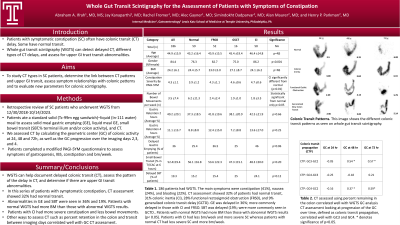Monday Poster Session
Category: Functional Bowel Disease
P2351 - Whole Gut Transit Scintigraphy for the Assessment of Patients with Symptoms of Constipation
Monday, October 28, 2024
10:30 AM - 4:00 PM ET
Location: Exhibit Hall E

Has Audio

Abraham A. Ifrah, MD, MS
Temple University Hospital
Philadelphia, PA
Presenting Author(s)
Abraham A. Ifrah, MD, MS1, Jay Kanaparthi, MD1, Rachel Fromer, MD2, Alec Gayner, MD1, Simindokht Dadparvar, MD3, Alan Maurer, MD4, Henry P. Parkman, MD5
1Temple University Hospital, Philadelphia, PA; 2Lewis Katz School of Medicine at Temple University, Boston, MA; 3Lewis Katz School of Medicine at Temple University, Philadelphia, PA; 4Temple University, Katz School of Medicine, Philadelphia, PA; 5Temple University, Strafford, PA
Introduction: Patients with symptomatic constipation (SC) often have colonic transit (CT) delay. Some have normal transit. Whole gut transit scintigraphy (WGTS) can detect delayed CT, different types of CT delays, and assess for upper GI tract transit abnormalities.
Aim
To study CT types in SC patients, determine the link between CT patterns and upper GI transit, assess symptom relationships with colonic patterns and to evaluate new parameters for colonic scintigraphy.
Methods: Retrospective review of SC patients who underwent WGTS from 12/30/2018-10/14/2023. Patients ate a standard solid (Tc-99m egg sandwich)–liquid (In-111 water) meal to assess solid meal gastric emptying (GE), liquid meal GE, small bowel transit (SBT,% terminal ilium and/or colon activity), and CT. We assessed CT by calculating the geometric center (GC) of colonic activity at 24, 48 and 72h, as well as the GC progression over imaging days 2,3, and 4. Patients completed a modified PAGI-SYM questionnaire to assess symptoms of gastroparesis, IBS, constipation and bm/week.
Results: 186 patients had WGTS. Demographics are shown in table 1. The main symptoms were constipation (41%), nausea (24%), and bloating (22%). CT assessment showed 32% of patients had normal transit, 31% colonic inertia (CI), 28% functional rectosigmoid obstruction (FRS0), and 9% generalized colonic transit delay (GCTD). GE was delayed in 36%; more commonly delayed in those with CI and FRSO. SBT was delayed (19%; were more commonly seen in GCTD. CT assessed using percent remaining in the colon correlated well with WGTS GC analysis (Table 1). CT assessment looking at progression of the GC over time correlated well with GC3 and GC4 as shown in table 1. Patients with normal WGTS had more BM than those with abnormal WGTS results (p< 0.05). Patients with CI had less bm/week and more severe SC whereas patients with normal CT had less severe SC and more bm/week.
Discussion: WGTS can help document delayed colonic transit (CT), assess the pattern of the delay in CT, and determine if there are upper GI transit abnormalities. In this series of patients with symptomatic constipation, CT assessment showed 32% had normal transit. Abnormalities in GE and SBT were seen in 36% and 19%. Patients with normal WGTS had more BM than those with abnormal WGTS results. Patients with CI had more severe constipation and less bowel movements. Other ways to assess CT such as percent retention in the colon and transit between imaging days correlated well with GC CT assessment.
Note: The table for this abstract can be viewed in the ePoster Gallery section of the ACG 2024 ePoster Site or in The American Journal of Gastroenterology's abstract supplement issue, both of which will be available starting October 27, 2024.
Disclosures:
Abraham A. Ifrah, MD, MS1, Jay Kanaparthi, MD1, Rachel Fromer, MD2, Alec Gayner, MD1, Simindokht Dadparvar, MD3, Alan Maurer, MD4, Henry P. Parkman, MD5. P2351 - Whole Gut Transit Scintigraphy for the Assessment of Patients with Symptoms of Constipation, ACG 2024 Annual Scientific Meeting Abstracts. Philadelphia, PA: American College of Gastroenterology.
1Temple University Hospital, Philadelphia, PA; 2Lewis Katz School of Medicine at Temple University, Boston, MA; 3Lewis Katz School of Medicine at Temple University, Philadelphia, PA; 4Temple University, Katz School of Medicine, Philadelphia, PA; 5Temple University, Strafford, PA
Introduction: Patients with symptomatic constipation (SC) often have colonic transit (CT) delay. Some have normal transit. Whole gut transit scintigraphy (WGTS) can detect delayed CT, different types of CT delays, and assess for upper GI tract transit abnormalities.
Aim
To study CT types in SC patients, determine the link between CT patterns and upper GI transit, assess symptom relationships with colonic patterns and to evaluate new parameters for colonic scintigraphy.
Methods: Retrospective review of SC patients who underwent WGTS from 12/30/2018-10/14/2023. Patients ate a standard solid (Tc-99m egg sandwich)–liquid (In-111 water) meal to assess solid meal gastric emptying (GE), liquid meal GE, small bowel transit (SBT,% terminal ilium and/or colon activity), and CT. We assessed CT by calculating the geometric center (GC) of colonic activity at 24, 48 and 72h, as well as the GC progression over imaging days 2,3, and 4. Patients completed a modified PAGI-SYM questionnaire to assess symptoms of gastroparesis, IBS, constipation and bm/week.
Results: 186 patients had WGTS. Demographics are shown in table 1. The main symptoms were constipation (41%), nausea (24%), and bloating (22%). CT assessment showed 32% of patients had normal transit, 31% colonic inertia (CI), 28% functional rectosigmoid obstruction (FRS0), and 9% generalized colonic transit delay (GCTD). GE was delayed in 36%; more commonly delayed in those with CI and FRSO. SBT was delayed (19%; were more commonly seen in GCTD. CT assessed using percent remaining in the colon correlated well with WGTS GC analysis (Table 1). CT assessment looking at progression of the GC over time correlated well with GC3 and GC4 as shown in table 1. Patients with normal WGTS had more BM than those with abnormal WGTS results (p< 0.05). Patients with CI had less bm/week and more severe SC whereas patients with normal CT had less severe SC and more bm/week.
Discussion: WGTS can help document delayed colonic transit (CT), assess the pattern of the delay in CT, and determine if there are upper GI transit abnormalities. In this series of patients with symptomatic constipation, CT assessment showed 32% had normal transit. Abnormalities in GE and SBT were seen in 36% and 19%. Patients with normal WGTS had more BM than those with abnormal WGTS results. Patients with CI had more severe constipation and less bowel movements. Other ways to assess CT such as percent retention in the colon and transit between imaging days correlated well with GC CT assessment.
Note: The table for this abstract can be viewed in the ePoster Gallery section of the ACG 2024 ePoster Site or in The American Journal of Gastroenterology's abstract supplement issue, both of which will be available starting October 27, 2024.
Disclosures:
Abraham Ifrah indicated no relevant financial relationships.
Jay Kanaparthi indicated no relevant financial relationships.
Rachel Fromer indicated no relevant financial relationships.
Alec Gayner indicated no relevant financial relationships.
Simindokht Dadparvar indicated no relevant financial relationships.
Alan Maurer: ICON Medical Imaging – Consultant, Employee.
Henry Parkman: Evoke Pharma – Consultant. Medtronic Enterra – Consultant. Takeda – Consultant.
Abraham A. Ifrah, MD, MS1, Jay Kanaparthi, MD1, Rachel Fromer, MD2, Alec Gayner, MD1, Simindokht Dadparvar, MD3, Alan Maurer, MD4, Henry P. Parkman, MD5. P2351 - Whole Gut Transit Scintigraphy for the Assessment of Patients with Symptoms of Constipation, ACG 2024 Annual Scientific Meeting Abstracts. Philadelphia, PA: American College of Gastroenterology.
